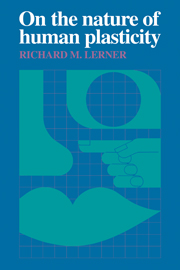Book contents
- Frontmatter
- Contents
- Foreword by Paul Baltes
- Preface
- 1 Perspectives on plasticity
- 2 The life-span view of human development: philosophical, historical, and substantive bases
- 3 Gene marking, recombinant DNA technology, and gene transfer: toward true gene therapy
- 4 Neuroanatomical bases of human plasticity
- 5 Human neurochemistry and the role of neurotransmitters
- 6 Evolutionary biology and hominid evolution
- 7 Comparative-developmental psychological bases of plasticity
- 8 Individual and group interdependencies
- 9 Toward future multidisciplinary efforts
- 10 Conclusions: On the limits of plasticity and the plasticity of limits
- References
- Author index
- Subject index
2 - The life-span view of human development: philosophical, historical, and substantive bases
Published online by Cambridge University Press: 22 March 2010
- Frontmatter
- Contents
- Foreword by Paul Baltes
- Preface
- 1 Perspectives on plasticity
- 2 The life-span view of human development: philosophical, historical, and substantive bases
- 3 Gene marking, recombinant DNA technology, and gene transfer: toward true gene therapy
- 4 Neuroanatomical bases of human plasticity
- 5 Human neurochemistry and the role of neurotransmitters
- 6 Evolutionary biology and hominid evolution
- 7 Comparative-developmental psychological bases of plasticity
- 8 Individual and group interdependencies
- 9 Toward future multidisciplinary efforts
- 10 Conclusions: On the limits of plasticity and the plasticity of limits
- References
- Author index
- Subject index
Summary
Human development, or more accurately child development, was often studied in the first several decades of this century within university institutes – for example, at Iowa, Minnesota, and Berkeley. Although these centers originally took a multidisciplinary approach, the pluralistic perspective began to erode by the 1950s and was eventually replaced by a single view of development, the psychological (L. P. Lipsitt, pers. comm., December 1979; D. S. Palermo, pers. comm., August 1980; see also Hartup, 1978). The 1970s were marked by calls for a return to interdisciplinary integration (e.g., Brim & Kagan, 1980; Bronfenbrenner, 1977; Burgess & Huston, 1979; Hill & Mattessich, 1979; Lerner & Spanier, 1978; Petrinovich, 1979; Riley, 1979; Sarbin, 1977), calls motivated primarily by instances of failure to confirm some key hypotheses of developmental psychological analysis.
A case in point involves attempts to use a biological model of growth, one based on an idealized maturational (organismic) conception of development, to account for data from the adult and aged years (Baltes, et al., 1980; Baltes & Schaie, 1973). According to this type of organismic conception, the adult and aged years are periods of decline. However, much of the data regarding age changes (e.g., in intellectual performance) during these life periods turned out to be inconsistent with this paradigm. For example, pertinent data sets revealed increasingly greater differences in individual change: As people grow older, the differences between them apparently increase (Baltes, 1979a; Baltes & Schaie, 1974, 1976; Schaie, Labouvie, & Buech, 1973).
- Type
- Chapter
- Information
- On the Nature of Human Plasticity , pp. 22 - 32Publisher: Cambridge University PressPrint publication year: 1984
- 1
- Cited by



